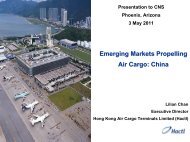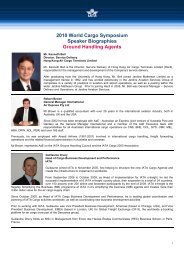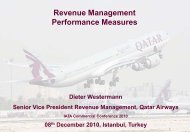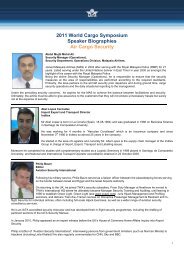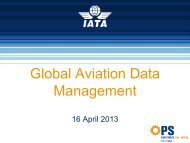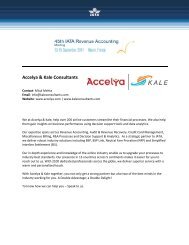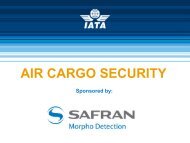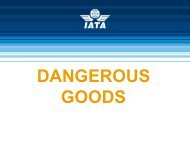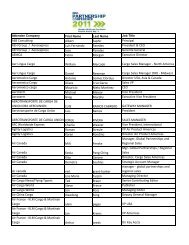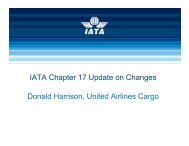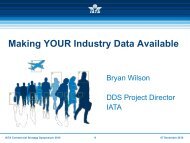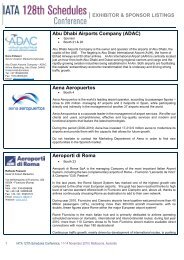Wednesday, 19 May 2010
Wednesday, 19 May 2010
Wednesday, 19 May 2010
Create successful ePaper yourself
Turn your PDF publications into a flip-book with our unique Google optimized e-Paper software.
Ground Damage<br />
Prevention, Key<br />
Element in Your<br />
Business Strategy
Opening of Working Session 3,<br />
Reflections on Track 2<br />
Michael Feldman, Former<br />
Director, Passenger, IATA
IATA Ground Damage Prevention:<br />
Learning from Experience, Forgetting<br />
g<br />
Key Lessons<br />
David Anderson, Head of<br />
Operational Safety, British<br />
Airways<br />
Joseph Suidan, Assistant<br />
Director, ISAGO, IATA
Ground Damage Prevention<br />
Learning from Experience<br />
David Anderson<br />
David Anderson<br />
Head of Operational Safety
Aircraft damage : some facts<br />
• Aircraft damage is a significant cost to airlines.<br />
• The repair costs are only the tip of the iceberg.<br />
• Most minor damage to aircraft is reported as ‘found’<br />
• Damage prevention has to be everyone’s goal.<br />
• Airlines do not seem to be well coordinated on damage prevention<br />
policies.<br />
• Some companies will dismiss employees rather than understand the root<br />
cause of fincidents id – this is a lost learning opportunity.<br />
• There is no consolidated reporting system so we don’t know the true scale<br />
of the challenge.<br />
• Each airline probably damages their aircraft in the same way at least once<br />
before learning lessons.<br />
6
How bad can it really be<br />
£225,000<br />
28 days<br />
£134, 000<br />
14 days<br />
£200,000000<br />
15 days<br />
31 days<br />
£230,000<br />
7
IATA Ground Damage Task Force<br />
• Set up in 2009<br />
• Agree that the cost of damage is unacceptable<br />
• Reducing damage needs a collaborative approach<br />
• Solutions need to align with ISAGO/IGOM<br />
• Start by collating data and understanding the problem.<br />
• We need data to identify hot spots<br />
Aircraft types<br />
Airports<br />
Phase of operation<br />
Equipment type<br />
Location of damage to aircraft<br />
8
What will the Task Force look at<br />
• First deliverable is to provide damage data, then:<br />
• Communication plans to share learning<br />
• Agree method for costing damage<br />
• Request a review of the insurance recovery process<br />
• Agree common reporting criteria<br />
• Provide ISAGO group with minimum equipment standards<br />
• Develop procedure to share best practice for equipment mods<br />
• Agree common policy to improve reporting culture.<br />
• Consider how behavioural training can be built into the project.<br />
• Determine minimum standards for ramp layout<br />
• Ensure training standards provide enough focus on aircraft damage<br />
prevention<br />
• Learn lessons ahead of new generation aircraft.<br />
9
Some observations<br />
• Damage data is currently limited to data produced by airlines<br />
individually or within existing groups.<br />
• There is a need for industry data to raise the profile of aircraft<br />
damage and drive accountability and solutions.<br />
• IATA ground damage prevention project is key in developing this.<br />
• Airline data is often very different to GHA or airport data.<br />
10
We need ALL damage to be reported.<br />
• The majority of ‘minor’ damage is found damage<br />
• The vast majority of significant damage is reported when it occurs.<br />
This allows us to better understand why it occurred but these<br />
are often one-off off incidents.<br />
• Some companies will penalise employees who cause damage.<br />
• Airlines report more damage than GHA’s<br />
• As an industry we need to improve reporting.<br />
• The IATA Task Force data will help with this.<br />
11
Global Safety Information Centre - GSIC<br />
Presentation Reporting Layer “Web Portal”<br />
i.e. Dashboard Style<br />
Report<br />
Report Report Report Report<br />
Report<br />
Grou und<br />
Dam mage<br />
ISAG GO<br />
IOS SA<br />
FD DA<br />
STEA ADES<br />
Safe ety<br />
Rep port<br />
Independent Databases<br />
12
Aircraft Ground Damage<br />
Query per Contributing Factors<br />
Dummy data for example<br />
only<br />
Aircraft Ground Damage and<br />
vehicles/equipment<br />
Accident Rates per Region<br />
(per 10,000 aircraft movements)<br />
Top Contributing Factors<br />
0.4<br />
0.35<br />
0.3<br />
0.25<br />
0.2<br />
0.15<br />
0.1<br />
0.05<br />
0<br />
World Africa China / North Asia Russia & CIS ASPAC Europe North America<br />
13
What does the BA data tell us<br />
Number of incidents (per A/C type) per 1,000 flights<br />
747’s mainly hold damage<br />
777<br />
0<br />
14
What can we do with the data<br />
• Gain buy in from airline, GHA’s s, airport authorities etc<br />
• Use the data to focus on ‘high risk’ or ‘high value’ events.<br />
• Identify airfields where damage occurs most frequently.<br />
• Ensure a robust reporting culture.<br />
• Understand why the damage is occurring.<br />
• Determine how to engage with staff and contractors.<br />
• Determine how damage costs can be captured and recoveries made.<br />
• Provide learning for the industry.<br />
• Involve manufacturers in the fix.<br />
15
What happens to someone who<br />
reports damage<br />
• Airlines and GHA’s need to be sure they understand the<br />
impact of how they approach aircraft damage.<br />
• We need to improve personal accountability amongst ramp<br />
employees.<br />
• Instant dismissal (unless damage is unreported) does not drive<br />
a responsible safety culture and may well drive reporting<br />
underground.<br />
• Understanding why employees make mistakes is the key to<br />
reducing damage.<br />
• Involve staff in the fixes.<br />
16
What about ISAGO / IGOM<br />
• Should assist through the following:<br />
• Setting a common set of procedures for turning a/c round<br />
safely.<br />
• Standardise training to deliver a higher and more consistent<br />
standard.<br />
• Remove differences between airlines when carrying out the<br />
same routine ramp tasks.<br />
• Enable standards to be set that will deliver a reduction in a/c<br />
damage. Eg common standards for chocking, coning,<br />
equipment parking, equipment positioning etc.<br />
• Monitor those standards to ensure they are maintained.<br />
• Identify airfields and GHA’s who cannot meet the standards<br />
and either provide support – or avoid!<br />
17
Before blaming your people consider,<br />
• Is your ground equipment correctly maintained.<br />
• Most equipment in use is not new and therefore does not have<br />
the latest safety features built in.<br />
• Do you modify it to prevent damage<br />
• Do manufacturers provide enough advice on retrofitting<br />
equipment.<br />
• Many airlines develop enhancements themselves but this is<br />
not fed back to the manufacturers.<br />
18
Learning from events<br />
• We need to share learning following damage events<br />
• There needs to be a just culture in all organisations.<br />
• We need to encourage all employees to report aircraft damage<br />
• We need to work with all interested parties<br />
• Investigate all damage events<br />
• Involve ground handlers in the investigation<br />
• Ensure the airport authorities accept their responsibilities<br />
<strong>19</strong>
What not to expect or accept!<br />
I was stay left side<br />
I don’t see anything<br />
It is two fer fornte<br />
The<br />
Because I don’t know the<br />
right side. Thank you<br />
20
Is the recovery process suitable<br />
Why should airlines pick up the cost of GHA damage<br />
The current recovery process only ‘scratches the surface.’<br />
• Costs that cannot be recovered include<br />
Cancellation costs<br />
Hotac<br />
Re-booking passengers on other carriers<br />
Loss of goodwill<br />
Ferry flights<br />
Loss of use of the aircraft, etc etc<br />
Is it appropriate that the airlines pick up this risk Would GHA’s be<br />
more careful about aircraft damage if they felt the pain like the<br />
airlines do<br />
21
Can you reduce cost and improve safety<br />
No damage<br />
events<br />
Good reputation<br />
Gain business<br />
Staff retention<br />
Management<br />
Commitment<br />
to Safety<br />
No insurance<br />
claims<br />
Lower business<br />
costs<br />
Ability to invest<br />
in training<br />
Ability to invest<br />
in people<br />
Ability to invest<br />
In equipment<br />
22
BA findings - common damage areas<br />
Hold 5 Damage Rates<br />
• Every 747-400 has damage to<br />
Hold 5<br />
• 60 man hours for small repair<br />
Door 2L/4L<br />
• Airbus & 737 sustained damage<br />
Stringers <strong>19</strong>/20 adjacent door 2L<br />
• Repair is minimum 4 days<br />
requires complete removal of rear<br />
galley<br />
23
Damage Example – 747 Hold 5<br />
24
Damage Example – 747 Hold 5<br />
Source of Damage<br />
25
AIRBUS – DOOR 2L<br />
26
AIRBUS – DOOR 2L<br />
27
Some fixes can be simple.<br />
Cheap modifications made to equipment<br />
28
ISAGO Round Table Discussion:<br />
i<br />
Champions And Challenges<br />
John Hatten, Director – Safety<br />
and Compliance, Delta Ground<br />
Services<br />
John Kleberg, Managing<br />
Director Quality Assurance –<br />
Airline Operations, United<br />
Airlines<br />
Joseph Suidan, Assistant<br />
Director, ISAGO, IATA
ISAGO<br />
IATA Safety y Audit for Ground Operationsp<br />
IGHC SAN - <strong>May</strong> <strong>19</strong>, <strong>2010</strong><br />
Discussion Document<br />
This document was used in the discussion of the subject<br />
matter above but does not fully represent the entire discussion<br />
32
Why is United Airlines<br />
supporting ISAGO<br />
33
IATA Safety Audit for Ground Operations<br />
What is it to us<br />
• Natural expansion of IOSA<br />
• A standardized and structured audit program of<br />
Ground Service Providers<br />
– Internationally recognized operational standards<br />
– Highly trained and experienced auditors<br />
• A model for operational risk & safety<br />
management<br />
• A system for registration and sharing of audits<br />
34
IATA Safety Audit for Ground Operations<br />
Why do we participate<br />
• Part of our Internal Evaluation Program<br />
• GSP’s minimally covered due to scope<br />
– 762 individual functions<br />
– 556 separate entities<br />
– 129 locations<br />
• Aims<br />
– To expand our oversight<br />
– To reduce ground hazards that affect flight safety<br />
– To reduce aircraft ground damage<br />
– To reduce personnel injuries<br />
– To avoid redundant audits<br />
35
ISAGO Standards & Recommended Practices<br />
(GOSARPs)<br />
Utilizes variety of standards<br />
• IATA Airport Handling Manual (AHM)<br />
• Other relevant IATA Manuals:<br />
– Dangerous Goods, Live Animals, Security, Airports<br />
• Relevant Industry Source Documents:<br />
– e.g. ISO 9001/14001, ACI Airside Safety Handbook<br />
• Relevant ICAO Annexes<br />
• Relevant JAA/EASA and/or FAA Regulations<br />
• Industry-proven best practices<br />
36
ISAGO Standards Manual (GOSM)<br />
GOSM 2 nd Edition - <strong>May</strong> <strong>2010</strong><br />
Covers all areas<br />
Section 1 ORM Organization and Management System<br />
Section 2 LOD Load Control<br />
Section 3 PAX Passenger Handling<br />
Section 4 BAG Baggage Handling<br />
Section 5 HDL Aircraft Handling and Loading<br />
Section 6 AGM Aircraft Ground Movement<br />
Section 7 CGM Cargo and Mail Handling<br />
37
Reduce And Share Audits<br />
Benefit for both us and the GSP<br />
Current situation<br />
Redundant audits<br />
With ISAGO<br />
One Audit per GSP<br />
ISAGO<br />
System<br />
-Multiple Audits per GSP<br />
-Fewer Audits per GSP<br />
-Audit sharing<br />
38
Audits and GSP’s<br />
• Audits planned or conducted by UA (2008-<strong>2010</strong>) <strong>2010</strong>)<br />
– Singapore Airport Terminal Services (SIN)<br />
– Swissport (LAS)<br />
– China Eastern (PVG)<br />
– Menzies (CUN)<br />
– Fraport (FRA)<br />
– Servisair (YUL)<br />
• Example of registered GSP’s with contracted services to UA<br />
– Aviapartner (AMS and FRA)<br />
– Dnata (DXB)<br />
– Singapore Airport Terminal Services (SIN) UA<br />
– Tansonnhat International Airport Ground Handling Services (SGN)<br />
39
Planning on future benefit<br />
• Internal Evaluation Program averages 18<br />
station audits per year<br />
– GSP’s audited during visit<br />
– Touches about 59 Providers or 10% of total<br />
• ISAGO currently has 46 registered GSP’s<br />
– Expanding quickly<br />
– No need for airline to visit registered GSP<br />
• Contractual requirement<br />
40
Challenges<br />
• Airline<br />
• Ground Service Provider<br />
– Stations<br />
– Headquarters<br />
• IATA<br />
41
Questions<br />
42
DGS<br />
<strong>2010</strong><br />
Safety, Security & Regulated Compliance
• Summary of DGS performance<br />
– Key statistics<br />
• Employment<br />
• Injuries<br />
– Injury rate<br />
• Flight Frequency<br />
• Aircraft incidents<br />
– Aircraft incident rate
Employment<br />
9000 9,000<br />
8,000<br />
7,000<br />
6,000<br />
5,000<br />
4000 4,000<br />
3,000<br />
2,000<br />
1,000<br />
0<br />
5,873<br />
6,612<br />
7,477<br />
6,300<br />
6,800<br />
7,200<br />
2005 2006 2007 2008 2009 EST<br />
<strong>2010</strong>
Injury Rates<br />
Per 100 Full time equivalent<br />
10.0000<br />
8.00<br />
8.76<br />
8.30<br />
7.66 7.22 7.49<br />
7.73<br />
6.00<br />
4.00<br />
200 2.00<br />
0.00<br />
2005 2006 2007 2008 2009 EST<br />
<strong>2010</strong><br />
Recordable
Flights Handled<br />
Flights<br />
900,000<br />
715,913 739,732 762,918<br />
705,136 725,000<br />
733,000<br />
600,000<br />
300,000<br />
0<br />
2005 2006 2007 2008 2009 EST <strong>2010</strong>
Damages<br />
120<br />
100<br />
97<br />
80<br />
71<br />
60<br />
40<br />
55<br />
48<br />
46 46<br />
20<br />
0<br />
2005 2006 2007 2008 2009 EST<br />
<strong>2010</strong>
Aircraft Damage Rate<br />
Per 10,000 departures<br />
160 1.60<br />
1.40<br />
1.20<br />
1.00<br />
0.80<br />
0.60<br />
0.40<br />
020 0.20<br />
0.00<br />
1.34<br />
102 1.02<br />
0.72 0.68<br />
0.63<br />
0.63<br />
2005 2006 2007 2008 2009 EST<br />
<strong>2010</strong>
Safety – Corporate Documentation<br />
Safety Policy, Safety<br />
Process & Corporate<br />
Safety Plan<br />
JSA & WHA<br />
Safety & Compliance<br />
Evaluation
Safety – Station Documentation<br />
Safety Alerts<br />
Safety Checklists<br />
Remote Parking<br />
Remote Parking<br />
Assessment
Safety, Security & Compliance<br />
• Safety Process<br />
– OSHA VPP<br />
– OSHA Corporate VPP<br />
– SMS (safety management system)<br />
• DGS internal SMS program<br />
– One key element is non-punitive incident reporting<br />
• IATA – ISAGO (Audit/certification)
IATA / ISAGO<br />
• DGS started working with the ISAGO team in<br />
early 2007<br />
• DGS corporate was first audited in 2008<br />
– Audit process needed ‘adjustment’<br />
• We continued our involvement and<br />
commitment to the concept as IATA / ISAGO<br />
matured
IATA / ISAGO<br />
• Port of Seattle<br />
– Notified all contract service providers that they<br />
would require / mandate ISAGO certification by<br />
February, 2011<br />
– This ‘timeline’ accelerated our plans<br />
• Airline partners interest t in program<br />
– Several of our business partners demonstrated a<br />
renewed interest
IATA / ISAGO<br />
• From a ground handling point of view, ISAGO:<br />
– Certification demonstrates a level of commitment<br />
and structure<br />
– <strong>May</strong> open business opportunities<br />
• Air carriers recognize the value of the certification<br />
• Competitive advantage over GSP that do not meet the<br />
ISAGO requirements
Closing<br />
• DGS believes in working for continuous<br />
improvement<br />
– OSHA VPP<br />
– Safety Management System<br />
– IATA / ISAGO<br />
• Making the cost of the program bring benefit to<br />
the operation is the measure of a successful<br />
program
ISAGO<br />
IATA Safety Audit for Ground Operations<br />
IATA Ground Handling Council<br />
San Diego, California, USA<br />
<strong>19</strong>th <strong>May</strong> <strong>2010</strong>
ISAGO Program Status<br />
As of 14th <strong>May</strong> <strong>2010</strong><br />
• Establishment of the ISAGO Pool<br />
• 40 member airlines<br />
• Conducted 11 free information seminars in all regions of the world<br />
• Over 850 Participants from more than 70 countries<br />
• Trained 271 auditors from 83 different airlines<br />
• 174 auditors from the Pool member airlines<br />
• Performed 174 audits since launch of the program<br />
• Program active in all Regions of the world<br />
• 46% of audits are corporate audits<br />
IATA Ground Handling Council<br />
<strong>May</strong> <strong>2010</strong>
ISAGO Program Status<br />
As of 14th <strong>May</strong> <strong>2010</strong><br />
• 40 Regulators/Airports formally supporting the program<br />
• Standards d Manual : Second Edition<br />
• Reduce numbers of standards<br />
• Combine OMS and STM sections<br />
• Facilitate corporate audits by Airlines (versus by AOs)<br />
IATA Ground Handling Council<br />
<strong>May</strong> <strong>2010</strong>
ISAGO Audit Pool : 41 member airlines<br />
(As of 14 th <strong>May</strong> <strong>2010</strong>)<br />
North America<br />
-Air Canada<br />
-Air Transat<br />
-Continental<br />
-Delta<br />
-United<br />
Latin America<br />
& The Caribbean<br />
-COPA<br />
-LAN<br />
-Mexicana<br />
-TACA<br />
-Adria -CSA<br />
-Air France -KLM<br />
-Alitalia -LOT<br />
-Austrian<br />
-BA<br />
-BMI<br />
-Brussels<br />
Airlines<br />
Middle East /<br />
North Africa<br />
Africa<br />
-Lufthansa<br />
-Malev<br />
-TAP<br />
-TAROM<br />
-Air Namibia<br />
-Air Zimbabwe<br />
-Comair<br />
-Ethiopian<br />
-Kenya Airways<br />
Europe<br />
Russia / CIS<br />
-Aeroflot<br />
-Egyptair<br />
-Iran Air<br />
-Libyan Airlines<br />
-Royal Air Maroc<br />
-Royal Jordanian<br />
-Saudi Arabian<br />
-Yemenia<br />
China /<br />
North Asia<br />
-Cathay Pacific<br />
-China Eastern<br />
-Air China<br />
-Air India<br />
-Korean Air<br />
Asia Pacific<br />
IATA Ground Handling Council<br />
<strong>May</strong> <strong>2010</strong>
ISAGO Audits Snapshot<br />
North ot America 2 %<br />
Europe 25 %<br />
Russia ussa&CS<br />
CIS<br />
Countries 4 %<br />
Middle East &<br />
NorthAfrica23%<br />
China & North<br />
Asia 7 %<br />
Latin America &<br />
The Caribbean 16 %<br />
Africa 10 %<br />
Asia Pacific 13 %<br />
IATA Ground Handling Council<br />
<strong>May</strong> <strong>2010</strong>
2009 ISAGO Audits<br />
120<br />
100<br />
80<br />
60<br />
40<br />
20<br />
2009 Target<br />
109<br />
80<br />
0<br />
Jan<br />
Feb<br />
Mar<br />
IATA Ground Handling Council<br />
Apr<br />
<strong>May</strong><br />
Jun<br />
Jul<br />
Aug<br />
Sep<br />
Oct<br />
Nov<br />
Dec<br />
<strong>2010</strong><br />
<strong>May</strong> <strong>2010</strong>
2009 year-end end Results<br />
Month<br />
Total<br />
25<br />
Feb 5<br />
Mar 8<br />
20 Apr 11<br />
Cum.<br />
Jan 4<br />
15<br />
10<br />
5<br />
0<br />
Jan Feb Mar Apr <strong>May</strong> Jun Jul Aug Sep Oct Nov Dec<br />
Corporate Audits<br />
Station Audits<br />
<strong>May</strong> 14<br />
Jun 25<br />
Jul 34<br />
Aug 43<br />
Sep 52<br />
Oct 73<br />
Nov 95<br />
Dec 109<br />
2009 109<br />
IATA Ground Handling Council<br />
<strong>May</strong> <strong>2010</strong>
Since 2008, 174 audits have been performed<br />
25 200<br />
21<br />
22<br />
174 180<br />
20 160<br />
140<br />
15<br />
Nbr of Audits / Month<br />
Cumulative Total<br />
14<br />
120<br />
10<br />
10<br />
11 11<br />
9 9 9<br />
10<br />
9<br />
100<br />
80<br />
5<br />
0<br />
6<br />
5<br />
5<br />
4<br />
4<br />
3 3 3<br />
2 2<br />
1<br />
1<br />
0 0 0 0 0<br />
Feb Mar Apr <strong>May</strong> Jun Jul Aug Sep Oct Nov Dec Jan Feb Mar Apr <strong>May</strong> Jun Jul Aug Sep Oct Nov Dec Jan Feb Mar April <strong>May</strong><br />
2008 2009 <strong>2010</strong><br />
60<br />
40<br />
20<br />
0<br />
IATA Ground Handling Council<br />
<strong>May</strong> <strong>2010</strong>
80 Corporate Audits conducted worldwide<br />
North ot America 2 %<br />
Europe 25 %<br />
Russia ussa&CS<br />
CIS<br />
Countries 4 %<br />
Middle East &<br />
NorthAfrica23%<br />
China & North<br />
Asia 7 %<br />
Latin America &<br />
The Caribbean 16 %<br />
Africa 10 %<br />
Asia Pacific 13 %<br />
IATA Ground Handling Council<br />
<strong>May</strong> <strong>2010</strong>
Audits cover the world’s BIGGEST ground<br />
service providers<br />
• A S E - Group<br />
• Airport Terminal Services<br />
• Aviance<br />
• Aviapartner<br />
• Celebi Ground Handling<br />
• Delta Ground Services<br />
• Dnata<br />
• Fraport<br />
• Groundforce<br />
• Menzies<br />
• Servisair<br />
• Swissport International<br />
• Worldwide Flight Services<br />
IATA Ground Handling Council<br />
<strong>May</strong> <strong>2010</strong>
Testimonial…..<br />
As a quality manager I am proud to say that this project is giving an incredible<br />
boost to our stations, even bigger than we could ever imagine. It fits into our<br />
way of working and has made us look at things very differently.“<br />
Eva Vanallemeersch<br />
Corporate Quality Manager,<br />
Aviapartner<br />
IATA Ground Handling Council<br />
<strong>May</strong> <strong>2010</strong>
Testimonial Cont....<br />
• “ ISAGO is a complete Set-Up for growth and focusing on<br />
custumers satisfaction for their needs towards Safety, HR,<br />
Ground Operations monitering/Quality,<br />
Risk Managment System, Auditing and corrective actions for<br />
continious i results and improvements“<br />
Hatem Ibrahim<br />
V.P Busuniness development<br />
ASE-Group<br />
IATA Ground Handling Council<br />
<strong>May</strong> <strong>2010</strong>
Testimonial i Cont…<br />
"ISAGO is the ideal program to support our goal for worldwide standardization<br />
within the Swissport family.<br />
Complemented with other initiatives like "IGOM", it will be "THE INDUSTRY<br />
STANDARD", jointly developed by all stakeholders<br />
...and we are proud to be part of it!“<br />
Michael Thuersam<br />
Head of Corporate Quality, Health & Safety<br />
Swissport Group Services LLC<br />
IATA Ground Handling Council<br />
<strong>May</strong> <strong>2010</strong>
Testimonial Cont…..<br />
We could not ask for a better standard for the GSPs to<br />
benchmark SAFETY in ground operation, the standard itself<br />
meets the requirements of Airlines and Ground Handlers.<br />
Mazen Qursha<br />
Manager Safety & Compliance<br />
Dnata -Dubai<br />
IATA Ground Handling Council<br />
<strong>May</strong> <strong>2010</strong>
Testimonial Cont…<br />
For NAS the implementation of the ISAGO program has been<br />
positive! Through ISAGO we have improved on existing<br />
processes and procedures which in turn have helped us<br />
achieve a higher level of operational safety and efficiency. We<br />
have seen a mutual benefit both for our organization and our<br />
airline partners.”<br />
Bruce Richterkessing<br />
General Manager &Chief Operating Officer,<br />
NAS-Kuwait<br />
IATA Ground Handling Council<br />
<strong>May</strong> <strong>2010</strong>
National Aviation Authorities<br />
List of supportive NAAs as of 14 th <strong>May</strong> <strong>2010</strong><br />
Country<br />
1 Austria DGCA<br />
2 Australia CASA<br />
3 Belgium CAA<br />
4 Canada TC<br />
5 China CAAC<br />
6 Chile DGAC<br />
7 Egypt ECA<br />
8 Ethiopia CAA<br />
9 France DGAC<br />
10 Hong Kong CAD<br />
National Aviation<br />
Authority<br />
Country<br />
11 Jordan CARC<br />
12 Lebanon DGCA<br />
13 Macau CAA<br />
14 The Netherlands IVW<br />
15 Nigeria NCAA<br />
16 Russia MAK<br />
17 Switzerland FOCA<br />
18 UK CAA<br />
<strong>19</strong> USA FAA<br />
National Aviation<br />
Authority<br />
IATA Ground Handling Council<br />
<strong>May</strong> <strong>2010</strong>
Airport Authorities<br />
List of supportive Airports as of 14 th <strong>May</strong> <strong>2010</strong><br />
Region Country Airport Authority<br />
North America<br />
Latin America & The Caribbean<br />
USA<br />
Canada<br />
Colombia<br />
Ecuador<br />
Peru<br />
El Salvador<br />
Honduras<br />
Jamaica<br />
Seattle-Tacoma International Airport<br />
Aéroports de Montréal (ADM)<br />
Calgary Airport Authority<br />
Vancouver Airport Authority<br />
Eldorado International Airport<br />
TAGSA Aeropuerto de Guayaquil<br />
Lima Airport Partners<br />
El Salvador International Airport<br />
Inter Airports Honduras<br />
Montego Bay Airport<br />
Africa South Africa ACSA Airport Company South Africa<br />
IATA Ground Handling Council<br />
<strong>May</strong> <strong>2010</strong>
Airport Authorities<br />
List of supportive Airports as of 14 th <strong>May</strong> <strong>2010</strong><br />
Region Country Airport Authority<br />
Italy<br />
Venice Marco Polo Airport<br />
Europe The Netherlands Amsterdam Schiphol Airport<br />
Asia Pacific<br />
North Asia<br />
Switzerland<br />
Australia<br />
Rep of Maldives<br />
China<br />
Hong Kong<br />
Unique<br />
Adelaide Airport<br />
Melbourne Airport<br />
Perth Airport<br />
Australian Airport Association<br />
Male International Airport<br />
Chengdu Shuangliu<br />
Capital Airports Holding Company<br />
Hong Kong Airport<br />
IATA Ground Handling Council<br />
<strong>May</strong> <strong>2010</strong>
Supportive Airports Authorities (as of 14 th <strong>May</strong> <strong>2010</strong>)<br />
YVR<br />
SEA<br />
YYC<br />
YUL<br />
AMS<br />
ZRH<br />
VCE<br />
BJS<br />
ESR<br />
MBJ<br />
CTU<br />
HKG<br />
Inter Airports<br />
Honduras<br />
LIM<br />
BOG<br />
GYE<br />
MLE<br />
Airport Company<br />
South Africa (ACSA)<br />
PER<br />
Australian Airport<br />
Association<br />
ADL<br />
MEL<br />
IATA Ground Handling Council<br />
<strong>May</strong> <strong>2010</strong>
ISAGO Registry<br />
Update as of 14 th <strong>May</strong> <strong>2010</strong><br />
• 38 Providers on the ISAGO Registry, operating at 46 locations:<br />
AGA, AMM, AMS, BEY, BOG, CAI, CMB, CMN, COR, DXB, EBB, FRA, GDN, HAN, HKG, HRE, HRG, ICN, JED, KUN, KWI, LIS, LXR, MBA, MIA,<br />
NBO, OPO, OTP, PRG, RAK, RUH, SGN, SIN, SSH, SVO, VNO<br />
IATA Ground Handling Council<br />
<strong>May</strong> <strong>2010</strong>
ISAGO<br />
IATA Safety Audit for Ground Operations<br />
>> www.iata.org/isago<br />
>> isago@iata.orgorg<br />
IATA Ground Handling Council<br />
<strong>May</strong> <strong>2010</strong>
Afternoon Networking Coffee<br />
Break and AppCal Meetings
The True Cost of Carelessness<br />
Carole Gates, Director, Risk<br />
Management & Insurance, IATA
Managing Costs the<br />
Risk Management Way<br />
IGHC <strong>May</strong> <strong>2010</strong><br />
Carole Gates, JD<br />
Director, IATA Risk Management & Insurance<br />
Montreal, QC gatesc@iata.org<br />
+1 514 245 2066 mobile<br />
+1 514 390 6805 direct<br />
IATA Risk Management & Insurance<br />
Page 2
IATA HAS ONE AIM<br />
To improve the risk profile of the Ground<br />
Service Provider (GSP) industry worldwide<br />
Why It’s the only way to reduce losses.<br />
IATA Risk Management & Insurance<br />
Page 3
IMPROVE THE RISK PROFILE<br />
Who are the beneficiaries<br />
Airlines<br />
GSPs<br />
Insurance companies<br />
Insurance brokers<br />
IATA Risk Management & Insurance<br />
Page 4
OTHER SIGNIFICANT STAKEHOLDERS<br />
Governments<br />
Airports<br />
Regulatory authorities<br />
Aircraft and equipment manufacturers<br />
IATA Risk Management & Insurance<br />
Page 5
IMPROVE THE RISK PROFILE<br />
ISAGO is important first step, but what next<br />
Embed risk management in ground operations<br />
Make sure that risk management is loss driven<br />
Collect meaningful data<br />
Utilize appropriate expertise to evaluate human factors—at a<br />
detailed level<br />
Provide a formula for all interested parties that will help improve<br />
the risk profile of the industry<br />
IATA Risk Management & Insurance<br />
Page 6
IMPROVE THE RISK PROFILE<br />
Next steps*<br />
*ISAGO<br />
Insurance Program<br />
ISAGO<br />
(IATA Safety Audit for<br />
*DATA Collection<br />
Ground Operations)<br />
*Risk Management<br />
*Human Factors<br />
Analysis<br />
IATA Risk Management & Insurance<br />
Page 7
IMPROVE THE RISK PROFILE<br />
IATA-led insurance program<br />
IATA has worked with airline and GSP underwriters in the<br />
international aviation insurance market to put this program<br />
together<br />
To provide incentives / benefits to GSPs who participate<br />
IATA Risk Management & Insurance<br />
Page 8
INSURANCE PROGRAM<br />
Insurers have agreed to<br />
Fully support IATA’s initiative to reduce ground losses worldwide<br />
Actively participate in an IATA-led insurance initiative<br />
Provide GSPs who commit to the ISAGO audit with benefits<br />
specifically designed d for them under the program<br />
Provide data (subject to all necessary permission being obtained)<br />
Create a forum<br />
IATA Risk Management & Insurance<br />
Page 9
INSURANCE PROGRAM<br />
How does a GSP participate<br />
Commit to becoming registered under the ISAGO audit<br />
program<br />
IATA Risk Management & Insurance<br />
Page 10
INSURANCE PROGRAM<br />
Airline responsibilities as an insurance buyer<br />
Support the ISAGO audit as well as the insurance program<br />
Make sure that GSPs have coverage in line with industry<br />
standards<br />
Make sure that GSPs have reasonable limits of liability (most<br />
airlines seek $300m)<br />
Conduct credit checks<br />
IATA Risk Management & Insurance<br />
Page 11
INSURANCE PROGRAM<br />
Insurer responsibilities<br />
To provide an insurance program that offers best terms and<br />
provides benefits to committed GSPs<br />
Activly support a unique partnership among all stakeholders<br />
Actively facilitate a reduction in ground losses<br />
To facilitate a forum of interested parties<br />
Provide key data in order to identify relevant loss control<br />
measures<br />
IATA Risk Management & Insurance<br />
Page 12
INSURANCE PROGRAM<br />
Specifics<br />
Open to GSP’s broker and all Lloyds brokers<br />
Just ask them to inquire about the program on your behalf<br />
Any questions, contact me<br />
IATA Risk Management & Insurance<br />
Page 13
Introducing the New Tool to<br />
Deliver Zero Accidents in Manual<br />
Handling<br />
Dave Snowdon, Managing<br />
Director, Pristine Condition<br />
Ltd.
INTRODUCING<br />
‘THE NEW TOOL’<br />
IN<br />
MANUAL HANDLING<br />
How would zero manual handling accidents improve your business<br />
All Pristine Condition materials (copyright, trademarks and IPR) remain the property of Pristine Condition Ltd.
IATA Ground Operations Manual<br />
(IGOM)<br />
Guy Schroeder, Director<br />
Ground Safety, Continental<br />
Airlines
IGOM<br />
IATA Ground Operations Manual<br />
Presented By: Guy Schroeder – Continental Airlines<br />
San Diego, California, USA<br />
16-<strong>19</strong> <strong>May</strong> <strong>2010</strong><br />
IGHC 17<br />
16-<strong>19</strong> <strong>May</strong> <strong>2010</strong>
IATA Ground Operations Manual (IGOM)<br />
Current State t<br />
For now each airline publishes their own Ground<br />
Operations Manual (GOM)<br />
For the same type of aircraft, each individual airline<br />
approach can lead to significant variations in requirements<br />
and standards<br />
Inconsistencies between different airlines requirements can<br />
lead to confusion<br />
increased safety risk<br />
increased risk of aircraft damage<br />
inefficient ground ops<br />
IGHC 18<br />
16-<strong>19</strong> <strong>May</strong> <strong>2010</strong>
IATA Ground Operations Manual (IGOM)<br />
Safety<br />
Management<br />
System (SMS)<br />
Evaluate<br />
Plan<br />
Safety<br />
Culture<br />
Implement<br />
AHM<br />
IGOM / TEM<br />
ISAGO / LOSA<br />
Risk Access<br />
Measure<br />
IGHC <strong>19</strong><br />
16-<strong>19</strong> <strong>May</strong> <strong>2010</strong>
IATA Ground Operations Manual (IGOM)<br />
For airlines:<br />
<br />
<br />
<br />
For GSP:<br />
<br />
<br />
<br />
For all:<br />
<br />
<br />
<br />
<br />
Benefits<br />
Improved compliance from ground agents<br />
Reduced time spent conducting operational audits<br />
Reduced manual production/maintenance costs<br />
Simplified work processes and SOPs<br />
Reduced training costs<br />
Reduced manual production/maintenance costs<br />
Single industry standards<br />
Simplified Service Level Agreements (SGHA) and reduced costs<br />
Enhanced safety<br />
Simplified audits and inspections<br />
IGHC 20<br />
16-<strong>19</strong> <strong>May</strong> <strong>2010</strong>
IATA Ground Operations Manual (IGOM)<br />
Benefits<br />
Share the same views towards safety, value<br />
and benefits by managing threats and reducing<br />
risk in ground operations<br />
IGHC 21<br />
16-<strong>19</strong> <strong>May</strong> <strong>2010</strong>
IATA Ground Operations Manual (IGOM)<br />
IGOM and ISAGO<br />
HDL 1.3.1 The Provider shall have procedures in accordance with requirements of<br />
customer airlines for the positioning of marker cones around specific parts of an aircraft<br />
for the purpose of preventing damage from the movement of vehicles or GSE. (GM)<br />
Guidance<br />
Properly placed marker cones create a buffer for preventing aircraft ground damage.<br />
Guidance may be found in AHM 630.<br />
HDL 1.3.1 will make direct reference to the corresponding IGOM requirement<br />
<br />
<br />
Facilitate the audit process<br />
Better understanding of the ISAGO Standards requirements (from both auditee and<br />
auditor)<br />
IGOM will complement ISAGO<br />
Many ISAGO Standards will refer to an IGOM section<br />
IGHC 22<br />
16-<strong>19</strong> <strong>May</strong> <strong>2010</strong>
IATA Ground Operations Manual (IGOM)<br />
Development<br />
Development of IGOM will take account of relevant<br />
publications such as IATA AHM, other IATA Publications (e.g.<br />
DGR, LAR, PCR) and company manuals (e.g. Airline<br />
and GSP) and manufacturers manuals.<br />
IGHC 23<br />
16-<strong>19</strong> <strong>May</strong> <strong>2010</strong>
IATA Ground Operations Manual (IGOM)<br />
Strategic Value & Simplification<br />
AHM will remain the high level guideline document<br />
IGOM will simplify SOPs & Operational processes<br />
IGOM shall be available to airlines, GSPs and regulators<br />
Simplification saves cost but it is necessary to assess<br />
the total industry benefits of standardisation<br />
IGHC 24<br />
16-<strong>19</strong> <strong>May</strong> <strong>2010</strong>
IATA Ground Operations Manual (IGOM)<br />
Provisional Timescale<br />
Form Task Force by end of <strong>May</strong> <strong>2010</strong><br />
Significant deliverables by end of <strong>2010</strong><br />
Responsibility is within the Task Force<br />
Proposed and coordinated by the Project Leader<br />
Analogous ISAGO GOSM<br />
IGHC 25<br />
16-<strong>19</strong> <strong>May</strong> <strong>2010</strong>
Moderator Closing Remarks and<br />
Close of Symposium<br />
Michael Feldman, Former<br />
Director, Passenger, IATA



